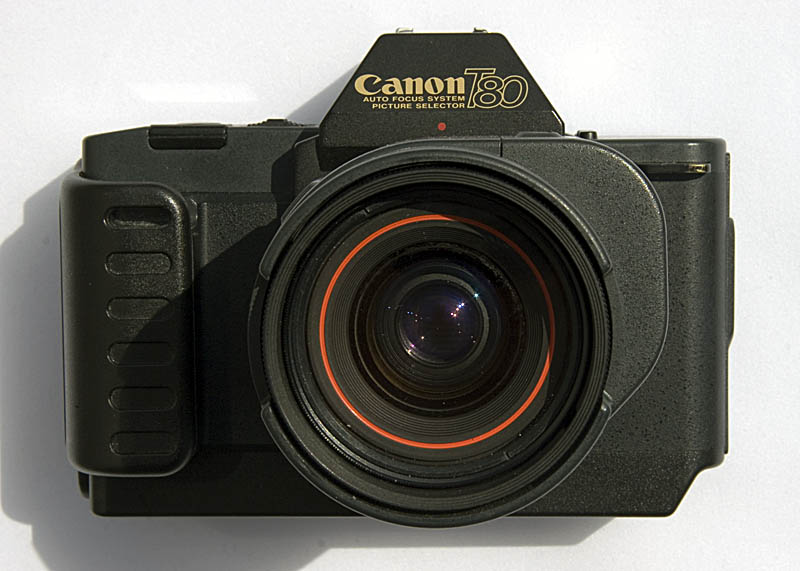
Lens Mount: FD bayonet/breech
Film type: 35mm
Approx. dates of manufacture: 1985-1986
Battery: four AAA
Approx. original price: unknown
Approx. street value: Low
The 1980s were a rush to incorporate autofocus onto single-lens-reflex (SLR) cameras. That's harder than it might sound, since you have to have a clear light path to go through the prism and the viewfinder, so you can't just stick a sensor in the middle of it where it would block the view.
But worse was the fact that nearly every SLR made (at least by that time) had interchangable lenses, so how do you accomplish the autofocus part and still keep your existing lens inventory? Camera makers loathe changing lens mounts and do it as rarely as possible because it gives its customers an opportunity to switch to a competitor's product line. By the mid 80s, Canon had fifteen years of the FD-mount firmly established, twenty if you include the mostly-compatible FL-series. They didn't want to give Nikon an opportunity to get disgruntled ex-Canon customers.
So Canon (and they weren't the only ones) tried to make autofocus camera work with their existing FD system—sorta. They took the in-camera focus-assist capability that was in their earlier AL-1 and then made a special autofocus lens that had a motor incorporated into the lens; the motor would do the focusing. The motor got its instructions from the camera though electrical contacts on the camera mount. They called these "AC" lenses. The mount was compatible with the FD system, so you could put a regular FD lens on your T80 and use it as a manual focus lens; or you could put an AC lens on any other FD-mount camera and use it as a manual-focus lens; but if you put the AC lens on the T80, you got autofocus capability on your T80 SLR.
.jpg) Canon
made three AC lenses, a 50mm ƒ/1.8, a short zoom (35-70mm) and a long zoom (75-200mm).
Canon
made three AC lenses, a 50mm ƒ/1.8, a short zoom (35-70mm) and a long zoom (75-200mm).
The big problem was that the autofocus system just wasn't that great. Minolta introduced the Maxxum 7000 and blew the doors off everything else, including this camera, and took the market by storm. People who wanted autofocus, and there were many, bought Minolta cameras and Minolta lenses. So Canon (and Nikon and nearly everyone else who entered the autofocus market) swallowed painfully, dropped backward-compatibility, and came out with a new lens mount and a new series of lenses—the EF series.
The T80 lasted about a year and became one of Canon's interesting but failed experiments, like the AL-1 and the ExEE and various other things they'd tried over the years.
My T80 has the short zoom on it. Using it, you can see why it didn't take the world by storm. First off, it's relatively loud. Part of this may be its age, but the grind of the motor as it turns is attention-getting to say the least. It's also much slower than Canon's newer EF lenses. And the autofocus itself is marginal. In bright light and aimed at a contrasty-subject, the autofocus does work. In lesser light it struggles—a lot.
And that's really the problem with autofocus—a few people are lazy but most people really wanted autofocus for two situations: fast action where you can't keep up, or in crappy light where it's hard to focus manually. If the camera is as incapable of doing those things as you are, then what's the point of having it at all?
If you don't bother with the autofocus, what you've got is a mid-tier Canon T70.
Someone on Wikipedia wrote that this camera is rare, but I think it's only comparitively so. They seem to run around $50 with a lens; it's possible the 50mm ƒ/1.8 might be more desirable but I don't really know why. The accessories (e.g. the Command Back 80) are likely where the money is; but then, I doubt many people would have use for one beyond the value of having it as a curiosity. It's a nice-enough camera but I think it's safe to say I'll never run a roll of film through it. Not when I have so many other cameras that do the same things far better.
For more information: Canon Camera Museum
Modern Photography magazine camera test: July 1986
One of Modern Photography magazine's Top Cameras
Camera manual: Orphan Cameras.com



